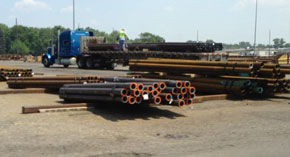People have used pipes for thousands of years. Perhaps the first use was by ancient agriculturalists who diverted water from streams and rivers into their fields.
 Archeological evidence suggests that the Chinese used reed pipe for transporting water to desired locations as early as 2000 b.c. Clay tubes that were used by other ancient civilizations have been discovered. During the first century a.d., the first lead pipes were constructed in Europe. In tropical countries, bamboo tubes were used to transport water. Colonial Americans used wood for a similar purpose. In 1652, the first waterworks was made in Boston using hollow logs.
Archeological evidence suggests that the Chinese used reed pipe for transporting water to desired locations as early as 2000 b.c. Clay tubes that were used by other ancient civilizations have been discovered. During the first century a.d., the first lead pipes were constructed in Europe. In tropical countries, bamboo tubes were used to transport water. Colonial Americans used wood for a similar purpose. In 1652, the first waterworks was made in Boston using hollow logs.
Development of the modern day welded steel pipe can be traced back to the early 1800s. In 1815, William Murdock invented a coal burning lamp system. To fit the entire city of London with these lights, Murdock joined together the barrels from discarded muskets. He used this continuous pipeline to transport the coal gas. When his lighting system proved successful a greater demand was created for long metal tubes. To produce enough tubes to meet this demand, a variety of inventors set to work on developing new pipe making processes.
An early notable method for producing metal tubes quickly and inexpensively was patented by James Russell in 1824. In his method, tubes were created by joining together opposite edges of a flat iron strip. The metal was first heated until it was malleable. Using a drop hammer, the edges folded together and welded. The pipe was finished by passing it through a groove and rolling mill.
Russell’s method was not used long because in the next year, Comelius Whitehouse developed a better method for making metal tubes. This process, called the butt-weld process is the basis for our current pipe-making procedures. In his method, thin sheets of iron were heated and drawn through a cone-shaped opening. As the metal went through the opening, its edges curled up and created a pipe shape. The two ends were welded together to finish the pipe. The first manufacturing plant to use this process in the United States was opened in 1832 in Philadelphia.
Gradually, improvements were made in the Whitehouse method. One of the most important innovations was introduced by John Moon in 1911. He suggested the continuous process method in which a manufacturing plant could produce pipe in an unending stream. He built machinery for this specific purpose and many pipe manufacturing facilities adopted it.
While the welded tube processes were being developed, a need for seamless metal pipes arouse. Seamless pipes are those which do not have a welded seam. They were first made by drilling a hole through the center of a solid cylinder. This method was developed during the late 1800s. These types of pipes were perfect for bicycle frames because they have thin walls, are lightweight but are strong. In 1895, the first plant to produce seamless tubes was built. As bicycle manufacturing gave way to auto manufacturing, seamless tubes were still needed for gasoline and oil lines. This demand was made even greater as larger oil deposits were found.
As early as 1840, ironworkers could already produce seamless tubes. In one method, a hole was drilled through a solid metal, round billet. The billet was then heated and drawn through a series of dies which elongated it to form a pipe. This method was inefficient because it was difficult to drill the hole in the center. This resulted in an uneven pipe with one side being thicker than the other. In 1888, an improved method was awarded a patent. In this process the solid billed was cast around a fireproof brick core. When it was cooled, the brick was removed leaving a hole in the middle. Since then new roller techniques have replaced these methods.
Since 1981 U.S. Tube Supply. has thrived and grown by putting the needs of the customer first in everything we do.
We have built a network of stocking yards which combined with our volume buying power and long term relationships with mills, suppliers, and freight carriers to make material procurement as easy and efficient as possible.
With focus and specialization on pipe and tube, we are dedicated to providing the right material for the job on time and on budget. Our stock consist of a wide array of inventory and sizes, our focus has always been on hard to find and heavy wall needs of manufacturing, machining, and fabrication industries.
Our stock is always filled with Carbon, Stainless, Alloy & Aluminum!
Mission Statement
U.S. Tube Supply is dedicated to providing pipe and tube solutions to our customers. By providing the most cost effective materials to specifications with minimal lead time U.S. Tube Supply strives to become a trusted partner with our customer.
Our guiding principle is to build business relationships benefiting all involved allowing us to improve our customers’ experience while serving our associates, suppliers, and community fairly and respectfully.
Visit our Blog and see why U.S. Tube Supply was named the supplier of choice!

